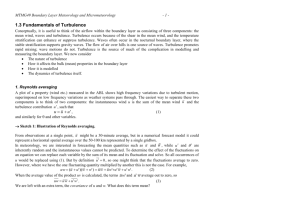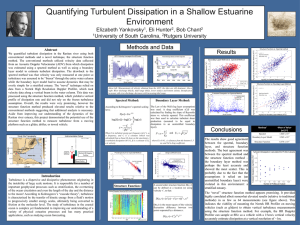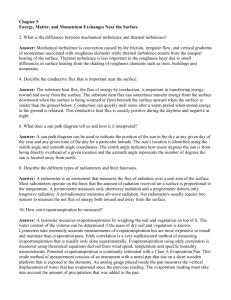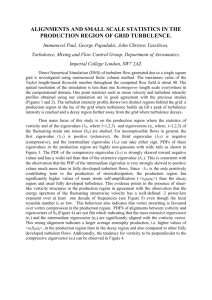Air Quality Meteorological
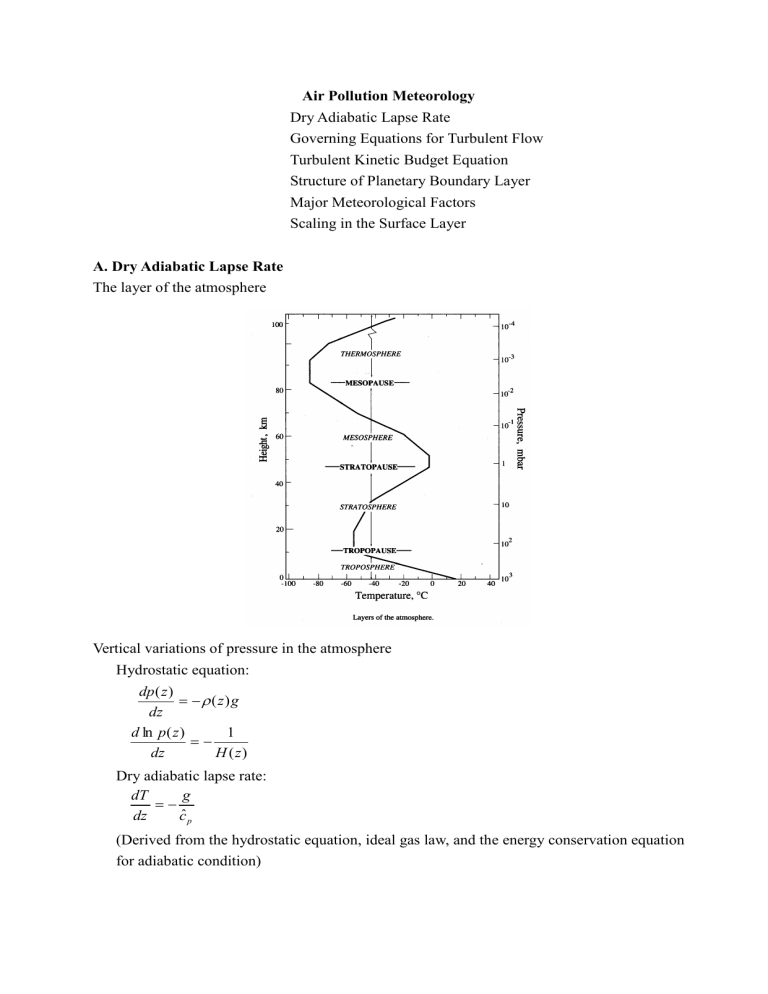
A. Dry Adiabatic Lapse Rate
The layer of the atmosphere
Air Pollution Meteorology
Dry Adiabatic Lapse Rate
Governing Equations for Turbulent Flow
Turbulent Kinetic Budget Equation
Structure of Planetary Boundary Layer
Major Meteorological Factors
Scaling in the Surface Layer
Vertical variations of pressure in the atmosphere
Hydrostatic equation: dp ( z )
( z ) g dz d ln p ( z ) dz
1
H ( z )
Dry adiabatic lapse rate: dT dz
g c
ˆ p
(Derived from the hydrostatic equation, ideal gas law, and the energy conservation equation for adiabatic condition)
Atmospheric stability is defined by comparing the temperature vertical gradient with dry adiabatic lapse rate
as: d
T /
z
Stable condition: d
;
Neutral condition:
Unstable condition:
; and d
d
The physical meaning of atmospheric stable condition is that the vertical atmospheric turbulence is destroyed or reduced by buoyant force; on the other hand, the vertical atmospheric turbulence is increased by buoyant force, as shown below.
B. Governing Equations for Turbulent Flow
(From: R.B. Stull (1993) “An Introduction to Boundary Layer Meteorology, Chapters 3 to 5)
Five equations form the foundation of boundary layer meteorology: the equation of state, and the conservation equations for mass, momentum, moisture, and heat. Additional equation for scalar quantities such as pollutant concentration is needed for air quality simulation.
Equation of state (Ideal gas law)
The ideal gas law adequately describes the state of gases in the boundary layer:
PV
nRT
Conservation of mass (Continuity equation)
Continuity equation describes the conservation of air mass as
t
(
V )
0 or
t
(
U j
)
x j
0
For turbulent motion smaller than mesoscale, the equation can be simplified into
V 0 or
U j
x j
0
Conservation of momentum (Newton’s second law)
U i
t
( )
U j
U i
x j
1
P
x i
( III )
1
ij
x j
( IV )
i 3 where I is the change of momentum with time,
II describe convection or advection,
III is the pressure gradient forces,
ijk
j k
( )
IV represents the influence of viscous stress,
V allows gravity to act vertically, and
VI describes the influence of the earth’s rotation (Coriolis effects).
For Newtonian fluid with zero bulk viscosity coefficient and constant dynamic viscosity, the influence of viscous stress becomes
2
U i
x j
2
. The Coriolis effects can be rewritten as f c
ij 3
U j
, where the Coriolis parameter is defined as f c
(1.45 10
4 s
1
) sin
and
is the latitude and
hours . Thus, the momentum equation is
U i
t
U j
U i
x j
1
P
x i
2
U i
x j
2
i 3 g
f
3
U j
Conservation of moisture
For total specific humidity in air ( q
T
), i.e., the mass of water (all phases) per unit mass of moist air, the conservation of water substance, assuming incompressibility, is
q
T
t
U j
q
T
x j
q
2 q
T
x j
2
S q
T
air
where
q
is the molecular diffusivity of water vapor in air and
S q
T
is the net moisture source term. Note that the water moisture equation generally divided into gaseous and condensed phases.
Conservation of Heat (First law of thermodynamics)
The first law of thermodynamics describes the conservation of enthalpy, which includes both sensible and latent heat. Thus, the water vapor in air not only transports sensible heat associated with its temperature, and it has the potential to release or absorb additional latent heat during any phase changes. Thus, the equation for potential temperature
is
t
U j
x j
2
x j
2
1
C p
Q j
*
x j
L E p
C p
where
is the thermal diffusivity and L p
is the latent heat associated with the phase change of E and
*
Q is the component of net radiation in j the j th
direction.
Conservation of pollutant (Mass balance equation for pollutant concentration)
The mass balance equation for pollutant concentration is
C
t
U j
C
x j
c
2
C
x j
2
S c
where
is the molecular diffusivity of pollutant and S c
is the body source term, for example chemical reactions.
For turbulent flow, the instantaneous value is spitted into mean and turbulent fluctuation, the so called Reynolds decomposition method. For equation with the mean variable, additional term may form for the above governing equations. For example, the moment equation becomes
U i
t
U j
U i
x j
1
P
x i
2
U i
x j
2
i 3 g
f c
ij 3
U j
u u i j
')
x j
where the last term is from the averaging of advection term
U j
U i
x j
U j
U i
x j
( U j
u j
')
( U i
u i
x j
')
U j
U i
x j
U j
u i
x j
'
u j
'
U i
x j
u j
'
u i
x j
'
U j
u i
x j
'
u j
'
U i
x j
u j
'
u i
x j
'
U j
U i
x j
u j
'
u i
x j
'
For incompressible fluid, u j
'
u i
x j
'
u u i j
')
x j
Similar is true for conservation of moisture, heat, and pollutant as the additional terms
( u q j
'
T
')
x j
,
( u j
x j
, and
( u c j
' ')
x j
. These additional terms are due to the effect of turbulent flow or turbulent fluctuations. Therefore, the number of unknowns is greater than that of governing equations. This is the turbulent closure problem. Because dispersion is governed by turbulence, whose physics remains largely impenetrable, dispersion models are semi-empirical in the sense that their development almost always involves the fitting of model parameters whose values are not know a priori .
C. Turbulence Kinetic Energy Budget Equation
Turbulence kinetic energy (TKE) per unit mass is defined as /
u
2 v '
2 w and it is a measure of turbulence intensity. It is directly related to the momentum, heat, moisture, and pollutant transport through the boundary layer. The TKE budget equation is
e
t
( )
U j
e
x j
i 3 g
v
u i
'
v
' ( III )
u u i j
'
U x j i ( IV )
( u e j
' )
x j
1
i
x i
( VI )
( VII )
where I is the change of TKE with time,
II describes the advection of TKE by mean wind,
III is the buoyant production or consumption term. It is a production or loss term depending on whether the heat flux u i
'
v
' is positive (during daytime over land) or negative (at night over land).
IV is a mechanical or shear production/loss term. The momentum flux u u is i
' j
' usually of opposite sign from the mean wind shear, because the momentum of wind is usually lost downward to the ground.
V represents the turbulent transport of TKE. It describes how TKE is moved around by the turbulent eddies u j
' .
VI is a pressure correlation term that describes how TKE is redistributed by pressure perturbations.
VII represents the viscous dissipation of TKE; i.e., the conversion of TKE into heat.
The individual terms in the TKE budget equation describe the physical processes that generate/consume turbulence. The relative balance of these processes determines the ability of the flow to maintain turbulence or become turbulence, and thus indicates flow stability.
Thus, the following dimensionless groups are derived from the buoyant production or consumption term (III) and the mechanical or shear production term (IV).
Richardson number:
1.
Flux Richardson number R f
is defined as the ratio of buoyant production or consumption term (III) to mechanical or shear production term (IV). Thus,
R f
g v
w '
v
'
u u i
' j
'
U i
x j
g v
w '
v
'
U
z
V
z
and the later form is for horizontal homogeneity and negligible subsidence. The R f
is negative, zero, and positive for statically unstable, neutral, and stable flows, respectively.
2. Gradient Richardson number R i
is defined as R i
g v
z v
U z
2
V z
2
by using the
K-theory or eddy diffusivity theory for correlating the turbulence covariance to the gradient of mean. The dynamic stability criteria are:
Laminar flow becomes turbulent when
Turbulent flow becomes laminar when
R i
R c
R i
R
T
The typical values of R c
and R
T
are 0.21 to 0.25 and 1.0, respectively.
3. Bulk Richardson number R
B
is defined as R
B
g
z
v
U
2
V
2
[( ) ( ) ]
by using measurements at discrete points instead of local gradient.
Monin-Obukhov length L is defined as L
v u
*
3
g w
') v s
and is a scaling parameter useful in the surface layer. By making the assumption of constant flux with respect to height, surface heat and momentum fluxes can be used to define turbulence scales and to nondimensionalize the TKE equation. The physical meaning of Monin-Obukhov length is that it is proportional to the height above surface at which buoyant factors first dominate over mechanical (shear) production of turbulence. For convective situations, buoyant and shear production terms are approximately equal at z=-0.5L
.
z
L
'
v
' s
v u
*
3
is very important for scaling and similarity arguments of surface layer and is called a stability parameter. It is negative and positive for statically unstable and stable conditions, respectively. The variation of R i
with
is shown in the following and note that
R i
for unstable conditions.
D. Structure of Planetary Boundary Layer
Planetary boundary layer (PBL) is defined as the region in which the atmosphere experiences surface effects through vertical exchanges of momentum, heat, and moisture.
The convective air motions generate intense turbulent mixing. This tends to generate a mixed layer, which has potential temperature and humidity nearly constant with height. When buoyant turbulence generation dominates the mixed layer, it is called a convective boundary layer (CBL). The lowest part of the ABL is called the surface layer. In windy conditions, the surface layer is characterized by a strong wind shear caused by friction. The boundary layer from sunset to sunrise is called the nocturnal boundary layer. It is often characterized by a stable layer, which forms when the solar heating ends and the radiative cooling and surface friction stabilize the lowest part of the ABL. Thus, there are two types of PBL: convective boundary layer (CBL) and stable boundary layer (SBL).
Three layer-model of the convective boundary layer: surface layer, mixed layer, and interfacial layer (Deardorff, 1979; Wyngaard, 1983).
Surface layer is the region at the bottom of the boundary layer where turbulent fluxes and stress vary by less than 10% of their magnitude. Thus, the bottom 10% of the boundary layer is called the surface layer, regardless of whether it is part of a mixed layer or stable layer.
Within the surface layer, the fluxes of momentum, heat and moisture are generally assumed to be independent of height and the Coriolis effect is generally negligible.
Prandtl’s mixing-length theory
Let u '
const
d u dy
, and v '
u '
Thus, u
' v
' c u
' v
'
and u ' v ' ι 2 ( d u dy
) 2
The turbulent shear stress
t
is equal to
u
' v
'
; therefore, the shear stress is
τ t
ρι 2 ( d u dy
) 2 or
τ t
ρι 2 d u dy d u dy
For constant flux layer, i.e., the flux of momentum is constant:
If the mixing length is proportional the distance from the wall, i.e.,
ky , then
τ
0
ρ k
2 y
2
( du dy
)
2
= constant. The equation is solved to show that: u
1 u k
* ln (logarithmic law for velocity) where u
*
= friction velocity u
1 ln yu u
* k v
*
5.56
where k = von Karman constant = 0.4
For the ambient atmosphere in neutral stability, the mean velocity profile within the surface layer is u u
*
1
z ln z o
for flat surface
u u
*
1 (
ln z
d ) z o
for rough surface
Note that the wind profile is only valid within the surface layer, i.e., above the surface rough region. z o
is the aerodynamic roughness length and its typical value are shown in the followings or computed approximated as z o
/ 30 , where
is the average height of the obstacles on the surface.
d is the displacement distance, as shown below:
Monin-Obukhov similarity or surface layer similarity: the mean-field and turbulence properties in the surface layer depend only on height z and three governing flow parameters: the buoyancy parameter / , the friction velocity o u
*
[(
2 xo
yo
)
1/ 2
(the square root of the kinematic surface stress), and the surface temperature flux w
0
. If water vapor is present, the surface virtual temperature flux, w
v
w
0.61
T wq , is used, where q is the fluctuation in specific humidity (mass water vapor/mass air) to account for the effect of water vapor on buoyancy. These three governing flow parameters define a length scale L
u T
*
3 o
/(
o
)
(the Monin-Obukhov length), a velocity scale u , and a temperature scale
*
*
w
o
/ u
*
.
Thus, any variable depends only on the three Monin-Obukhov governing parameters. That is, the variable, when made dimensionless by z , u , and
*
*
, is universal (i.e., the same in all surface layer) function of / , as shown below. The independent variable is a stability index. Roughly speaking, the magnitude of the length scale L corresponds to the height at which the shear and buoyant production (or destruction under stable conditions) rates of turbulent kinetic energy are the same.
The turbulence in mixed layer is usually convective driven, although a nearly well-mixed layer can form in regions of strong winds. Convective sources include heat transfer from a warm ground surface and radiative cooling from the top of the cloud layer. The resulting turbulence tends to mix heat, moisture, momentum, and pollutant uniformly in the vertical, as shown in the following. Different scaling parameters are used in mixer layer: z i
as a length scale instead of L , a new velocity scale w
*
gHz i
C T p o
1/ 3
instead of , and the temperature scale is
*
H
C w p *
, where H is surface heat flux,
is the air density, C p
is the specific heat at constant pressure, T is the surface temperature. o
Stable boundary layer (SBL) or nocturnal boundary layer (NBL)
A SBL is common over land at night. Under these conditions, h can vary form a few tens of meters with light winds to several hundred meters with strong winds. Caughey et al. (1979) have proposed a stable layer scaling using h as the length scale and u
*
as a velocity scale since stable layer turbulence is mechanical and not convective. Because nighttime boundary layer is usually not in equilibrium, Nieuwstadt (1984) has proposed a new local scaling approach, in which a local Obukhov length
is defined as
3/ 2
g
T w ' '( )
.
Turbulence in the SBL is produced by shear and destroyed by buoyancy and viscous dissipation. The competition between shear and buoyancy results in turbulence intensities that are typically much smaller than those found in the CBL. The height of SBL, h s
, is also small relative to that of the CBL and can be estimated as h s
0.4( u L f
*
1/ 2
, typical value of
100 m. Note that as opposed to the daytime mixed layer (ML) which has a clearly defined top, the SBL has a poorly defined top that smoothly blends into the RL above. The top of the ML is defined as the base of the stable layer, while the SBL top is defined as the top of the stable layer or the height where turbulence intensity is a small fraction of its surface value.
Observations have shown that
*
w
o
/ u
*
shows much smaller variations than either w
o
or u and Venkatram (1980) found that varied slightly around 0.08
* o
C during the
Minnesota experiment. Field data from Minnesota and Cabauw show that the variation of high frequency component of
in the SBL can be represented as w
w u
*
z h s
) a
, where the exponent a varies between 1/2 and 3/4. On the other hand,
has a substantial v low frequency component and it is believed that mesoscale flow and/or local topographical effects determine its magnitude.
Evolution of potential temperature is shown to demonstrate the diurnal variation:
E. Major Meteorological Factors
Major meteorological factors affecting air pollution transport are:
Horizontal wind speed and wind direction: The horizontal wind is generated by the geostrophic wind component, i.e., the pressure gradient wind at top of the PBL and altered by the contribution of terrain frictional force and the effects of local meteorological winds, such as see breeze, mountain/valley upslope/downslope winds and urban/rural circulations.
Synoptic system and topographic effect: The atmospheric vertical motion due to low/high pressure systems or complex terrain effects. The horizontal motion is clockwise diverging spiral wind for an anticyclone high pressure system in the northern hemisphere and the vertical motion is subsiding motion.
Temperature inversion: The strength of elevated temperature inversion limits the height of
PBL.
Atmospheric stability: A way of categorizing the turbulence status of the atmosphere, which affects the dilution rate of pollutants.
Atmospheric stability can be characterized by several methods or parameters:
Empirical method such as Pasquill scheme or Turner method
Flux Richardson number, R f
, which is defined as the ratio of the rate of dissipation (or production) of turbulence by buoyancy to the rate of creation of turbulence by shear. R f
<
0 for unstable condition, = 0 for neutral, and > 0 for stable condition.
Gradient Richardson number;
Monin-Obukhov length, L : L < 0 for unstable condition, = 0 for neutral, and > 0 for stable conditions.
Height of PBL
Neutral condition: z i
(0.15 ~ 0.25) u
* f
, where f
4
1
(1.46 10 s ) sin
and
is the latitude. Note that the actual PBL height is often lower than this equation since large scale processes produce an elevated inversion layer whose bottom elevation represents the actual
PBL height.
Unstable condition:
2
t t o
Hdt
C p
T o
[
2
t
Hdt
C t o
(
p d
)
]
1/ 2
, where H is surface heat flux,
is the air density, C p
is the specific heat at constant pressure,
T o
is the surface temperature change between time t o
(sunrise) and t . In unstable conditions, R f
, R i
and L are negative and
–L
is the height that separates mainly mechanical turbulence below from mainly convective turbulence above.
Stable condition: Stable conditions are typically encountered over land during clear nights with weak winds. Under these conditions, a ground based temperature inversion is present and the temperature increases with height from z
0 to z
z i
, the top of the stable PBL.
Mechanical turbulence, however, even though strongly attenuated by the downward hear flux
(
0) , creates a mixing layer from z
0 to z
h ,where h can be much lower than z i
.
The steady state asymptotic value h eq
of h(t) is h eq
0.4
u L
* f
.
The Monin-Obukhov length L is a parameter that characterizes the stability of the surface layer and is calculated from ground level measurement as
L
CpTu
*
3 gH (1
0.07
)
B
z u
*
3 w
*
3
(1
0.07
)
B z i
u
*
3
, where B is the Bowen ratio, i.e., the ratio w
* of sensible to latent surface heat flux, which can be estimated as B
T 0.01
z
2500
q
, where
T / z is the vertical temperature gradient and q / z is the vertical specific humidity
gradient (both at the surface). Note that the sensible heat flux is generally proportional to the vertical temperature gradient, while the latent heat flux is the enthalpy flux of water vapor. L and also be estimated empirically as a function of the Turner class and z o
, as shown below, where the empirical curves have been fitted with power law function such as 1/ L
az o b
and the values of a and b are listed in the following.
Surface heat flux H is defined as H
p
' '
K h
C p
T
z
d
with gradient theory or
K-theory, in which the heat flux is proportional to the temperature gradient. The potential temperature is defined as
( )
( )
d z ; thus, H
K h
C p
z
z
0
, where K h
is the coefficient of eddy heat conduction.
An approximate estimate of the gradient Richardson number R i
is:
Unstable condition: R i
z
L
;
Stable condition: R i
The relation between gradient Richardson number, R i
, and bulk Richardson number, R b
, is
R i
R b r
2
, where r is the exponent of the power law for mean wind speed profile as u
1 z r
. A typical value of r in flat terrain is 1/7 or 0.16 and it can be up to 0.4 in urban z
1 area. Note that the relation between gradient Richardson number, R i
, and flux Richardson number, R f
, is R f
K h
K m
R i
, K h
is the coefficient of eddy heat conduction and K m
is eddy viscosity.
Variances of wind components
Neutral condition:
u
au
*
,
v
bu
*
, and
w
cu
*
and a
, b
1.92 0.05
, and c
1.25 0.03
for flat terrain. In rolling terrain, a and b are larger, but c does not seem to change.
Unstable condition:
w z
1.25
u
*
z
L
1/ 3
for surface layer over both flat and rolling terrains. For large z in unstable condition,
becomes independent of u w
*
and is given as
w
( )
1.3
gHz
.
u
v
u
*
z i
L
1/ 3
for surface layer in stable and unstable (but not neutral) conditions.
For the entire PBL under unstable condition,
w w
*
1.8
z
2 / 3 z i
z i
1/ 2
, and
Caughey and Palmer (1979) have suggested the coefficient to be 2.5 instead of 1.8 from fitting the field experimental data. surface value ( z
0 ) of
u
u
w w
* * v
c
0.5 2
z
1/ 2 z i
0.3
z
1/ 2 z i
1/ 2
, where c is the
/ w
*
or
v
/ w
*
and a typical value is c
0.74
.
F. Scaling in the Surface Layer
The similarity profile for mean wind speed is
u
*
ln
z z o
m
, where
is a m stability function and
m
is defined as
m
z o
/ L
[1
d
, where the nondimensional wind shear
u
*
z
. The values of
m
( / ) are:
Neutral:
1 ; m
Unstable:
m
Stable:
m
Thus, the values of
m
( / )
Neutral:
0 ; m
are:
1/ 4
or
m
1/ 3
or
m
4 m
3
1
Unstable:
m
2 ln
(1
x )
2
ln
x
2
(1 )
2
1
2 tan x
2
, where x
1 15 z
L
1/ 4
Stable:
m
The nondimensional temperature gradient nondimensional wind shear, where
h z L is defined as
h
z
T
*
z
is the potential temperature and
, similar to the
T is the temperature
* scaling parameter T
*
Neutral condition:
H
C u p *
1 h
. The values of
are: h
Unstable condition:
h
1/ 2
or
h
0.74(1 9 / )
1/ 2
Stable condition:
h
or
h
The potential temperature
at any height is
z
z
T
*
ln
z z o
h
from the integration of the definition equation of the nondimensional temperature gradient, where
h z
z o
/ L
1
d
and its values are:
Neutral condition:
0 h
Unstable condition:
h
2ln[0.5(1
Stable condition:
h
The standard deviation of horizontal and vertical wind velocities can be scaled as
u
/ u
*
1 z i
L ,
v
/
Neutral condition: u
*
2 z L i
, and
1
,
w
/ u
*
3
. Their values are:
2
, and
3
Unstable and stable conditions:
1
2
i
1/ 3
Unstable condition:
3
z L
1/ 3
Stable condition: The large scatter of data points has not yet allowed a clear conclusion.


